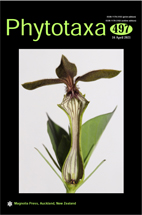Abstract
Chondrus canaliculatus is a red seaweed endemic to Peru and Chile. The name currently represents the only species classified in Chondrus from the southern hemisphere. Based on previous phylogenetic analyses, C. canaliculatus is polyphyletic with respect to Chondrus and possesses unique morpho-anatomical features that distinguish it from other genera in the Gigartinaceae. In this study, expanded phylogenetic analyses using rbcL and COI sequences, a combined data set, and morphological details were further examined to address the taxonomy and evolutionary systematics of C. canaliculatus. Genetic analyses placed C. canaliculatus well within the genus Mazzaella and therefore Mazzaella canaliculata comb. nov. is proposed. Mazzaella canaliculata is distinguished from the other Mazzaella from the southern hemisphere by its dichotomous branching, secondary filaments that persist and leave a well-defined involucre, the absence of terminal tubular cells, and tetrasporangia that are borne from secondary filaments from inner cortical and outer medullary cells. The distributional range of M. canaliculata is extended from the central coast of Peru, Bahía de Pucusana, Lima (12° S) to Chiloé, Chile (41° S). This study contributes to the systematics of the Gigartinaceae and formally validates a problematic species based on a combined analysis of molecular, morphological and anatomical data using recently field collected specimens.

